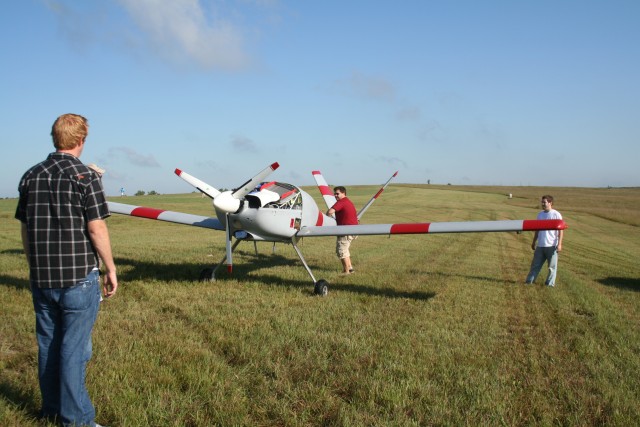FORT RILEY, Kan. - The University of Kansas Aerospace Engineering department traveled to Fort Riley Aug. 28 to test its Meridian Unmanned Aircraft System.
Five students accompanied by two associate professors brought the plane for a test run and hoped for a successful flight. The team stood in awe as the plane lifted off the ground in the late afternoon.
"Eight minutes might not seem like a long time, but for the first flight, we now have tons of data, which right now looks very encouraging for the aircraft performing as we expected it to," said Bill Donovan, of Lawrence, Kan., a doctoral student in aerospace engineering and lead designer.
"It was a little surreal," Donovan said. "We all stood there, and it took off and performed exactly as I'd envisioned it a thousand times before. Then, when it came in and landed and I realized it was back safely, it was just a great feeling."
The Meridian is a remote controlled 1,100-pound aircraft with a 26-foot wingspan. It is designed for low-altitude operations with a mission of mapping outlet glaciers in Antarctica and Greenland for the Center for Remote Sensing of Ice Sheets based at KU.
It has taken nearly five years to build and test the aircraft. It will assist researchers in compiling data by allowing flight passes at slower speeds. The plane also is able to fly at lower altitudes along the icy terrain.
The team had wanted to find a pre-made vehicle but later realized building the aircraft from the ground up was the better option.
"There are so many benefits to being able to use an unmanned vehicle," said Richard Hale, associate professor of aerospace engineering at KU and the project leader. "Aside from the danger, there also are considerations about fuel for a full-size plane, as well as the length of a possible mission. With a human pilot, you have to think about fatigue, food, and he might need to take a nap. With this vehicle, we can work to eliminate these obstacles."
This test was done at Fort Riley because the plane is required to fly in restricted airspace. The aerospace engineering department began running flight tests about four years ago with a helicopter. They then moved to a remote controlled hobby plane that has had autopilot equipment added to it so it was no longer able to fly outside of restricted airspace.
A friend of Kelly Gulker, air traffic and airspace officer at Fort Riley, who works at Range Support, said Fort Riley would be a good spot for the test flight of the smaller remote controlled plane and now the Meridian. And the students and professors couldn't have asked for a better day.
"We had perfect weather, a great sky, and the people at Fort Riley have been outstanding to work with," Donovan said. "They have restricted airspace, and with a UAV, you can't just fly anywhere, so they have been extremely helpful."
"Mr. (Ken) Neff, Mr. (Lee) Jones and Mrs. (Chris) Jeffrey at Range Support," Gulker said. "They've allowed us to have a flexible schedule and sequence the airspace for the device inside the restricted area, and Mr. Neff had his crew come out here and prep the ground for them. They've been fully supportive of them since they've been coming out here. Those are kind of the heroes behind the scenes."
The plane is shipped without the propeller and wings. The wings are installed with a single push pin retention mechanism. With three people the plane can be fully assembled in 15 minutes.
The crew is expected to flight test the aircraft in Utah in the coming weeks. They are set to deploy to Antarctica in December and Greenland sometime in 2010.


Social Sharing